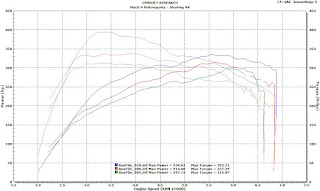 In November we took the Focus RS to our annual Mach V Track Day, which is a NASA High-Performance Driving Event (HPDE) that we sponsor at Summit Point Raceway each year. Then earlier this month we put the car back on the dyno for some custom ECU tuning. We were pleasantly surprised with the results in both cases.
In November we took the Focus RS to our annual Mach V Track Day, which is a NASA High-Performance Driving Event (HPDE) that we sponsor at Summit Point Raceway each year. Then earlier this month we put the car back on the dyno for some custom ECU tuning. We were pleasantly surprised with the results in both cases.Driving the RS on track was quite pleasant. The compromises that we perceived on the street -- ride too stiff, seats too huggy -- disappeared on track. The suspension (in normal mode) worked perfectly, and the seats kept us from having to brace our knees against the door in corners. The grip is amazing! Note, too, that our car is on regular street tires -- Michelin Pilot Super Sport, not the optional super-gummy Sport Cup 2 tires. We did not find the car understeer-y. Sure, it can push wide if you get on the power hard too early in a corner, but steady-state cornering was nicely balanced.
The car really goes around corners quite well, and that magical Rear Drive Unit definitely makes its presence known, especially in tighter corners, where just when you think the back end is about to wash out, instead the car just tracks neatly around the corner.
We did briefly try the Sport (harder) shock mode. It was far too stiff for the relatively bumpy track surface of Summit Point Main circuit, and we had to back off in order to stay on track, so we switched back to Normal mode.
 We drove the car for about eight 20-minute track
We drove the car for about eight 20-minute track sessions. In that time the car never complained, and we saw no Check Engine lights, no rear drive unit issues, and no brake fade. We did rotate the tires halfway through the weekend, but wear didn't seem terrible. (We tried not to punish the tires too much -- those tires are not cheap, and overheated Pilot Super Sports get greasy.)
The power was impressive. The car really launches out of corners, and we caught quite a few other cars on corner exit, since we could get on the gas far earlier than most 2WD cars. Speaking of gas, if we thought the car got bad mileage on the street, it is drastically worse on track. We had to fill up after each session, or we'd start to run out of fuel at the end of the second session.
Some time after we got back from the track, we received a nice letter from Ford corporate, advising us that the car will use more oil if you track it. Why yes, now that you mention it, it did consume maybe a third of a quart from our track outing. We topped off with Motorcraft 5W50. We'll probably switch to a Motul oil long-term, but we didn't have any Motul 5W50 around at the time.
 A couple of weeks ago we strapped the car back onto the dyno to see if we could squeeze any extra horses from the mechanically-stock car. Turns out we could. To review, the car previously produced 314 whp and 337 lb-ft. After some adjusting of various boost/fuel/timing tables, and a few other settings, we were able to manage 335 hp to the wheels, and a whopping 394 lb-ft! That's a 21 hp gain, and a 57 lb-ft improvement.
A couple of weeks ago we strapped the car back onto the dyno to see if we could squeeze any extra horses from the mechanically-stock car. Turns out we could. To review, the car previously produced 314 whp and 337 lb-ft. After some adjusting of various boost/fuel/timing tables, and a few other settings, we were able to manage 335 hp to the wheels, and a whopping 394 lb-ft! That's a 21 hp gain, and a 57 lb-ft improvement.With the increased power the car shoots forward under hard acceleration with even more urgency, especially around the 3000-4500 RPM torque peak. It's pretty dramatic.
We are seeing that 2017 Focus RS models are finally available, and that dealerships are starting to offer the car without Additional Dealer Markup (ADM). Some people even report purchasing a car under MSRP. That makes the Focus RS even more of an amazing performance buy.
